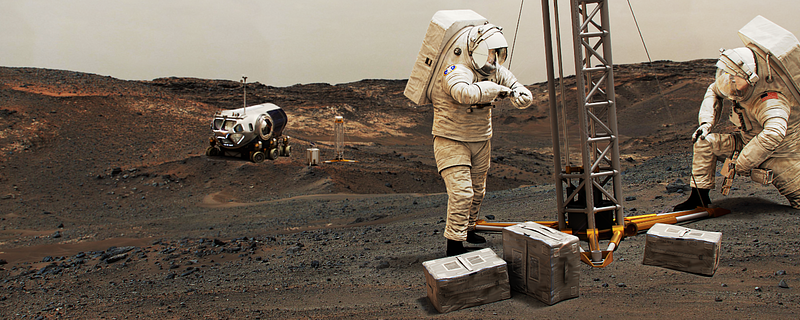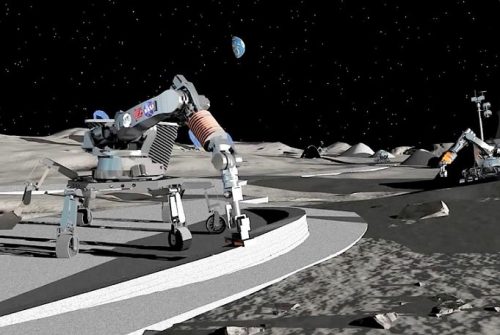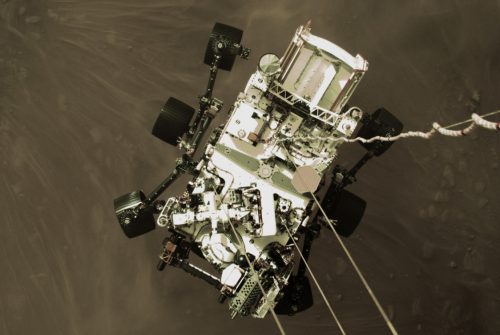The 5 technologies to go to Mars
2 December 2020 | Written by Alberto Laratro
From oxygen production to hi-tech spacesuits, let's find out which innovations will allow us to set foot on the red planet

By the 30s, NASA would like to be able to bring the first human crew to Mars. An event of historical significance but which will test our technical, technological and human skills. A journey of 225 million km lasting several months in which it will be necessary to bring with you everything you need to live and survive in hostile space and subsequently Martian conditions. We have chosen the five technologies that we believe will be essential to accomplish this feat.
Oxygen production. To survive, human beings need to eat, drink, be in a social environment with enough space, but above all, and this is definitely the most urgent need, they need to breathe. The good old mixture of oxygen, nitrogen and other gases we call air is an option that we just can’t do without, not even on Mars. If we are able to carry a large supply of the precious oxygen molecules with us, for extended missions like the Martian ones we absolutely need a way to produce it locally.
Researchers from the University of St. Louis have developed an efficient method for extracting oxygen from the little water found on Mars. Through a particular electrolysis process, the researchers were able to produce 25 times the amount of oxygen of MOXIE, the oxygen extraction experiment mounted on the NASA Perseverance rover currently on its way to Mars. Systems of this type would also find applications on Earth, for example to generate oxygen inside submarines.
Electric energy. In our cities we take it for granted, but electricity is a commodity of primary importance as it makes everything work. From the air conditioner to our computer, passing through the refrigerator or the pump that brings water to our apartment. The same will be true for Martian missions which will not be able to do without a constant influx of fail-safe electricity. When the air you breathe is produced by a system that consumes electricity, the last thing you want is a blackout.
If solar energy seems an excellent choice for producing energy, remember that Mars, like on Earth, is subject to the day-night cycle. Not only that, the sandstorms that cyclically sweep the surface of the planet, risking to cover the panels, reducing their efficiency. For this reason, NASA is seriously thinking about using nuclear energy to guarantee astronauts a constant flow of energy, a certainly safer choice with regard to the production of electricity but which will require a whole series of additional precautions, especially in phase launch of the mission.
Landing. Of course, none of the technologies reported in this article would make sense if we couldn’t ensure a smooth landing on the surface of Mars. The largest object we’ve ever sent to Mars, the Curiosity rover (and now Perseverance, currently on its way) is the size of a car. But bringing in humans will require a much larger landing vehicle. To ensure its safety, the American space agency is developing a huge inflatable heat shield that will allow it to slow down in the thin Martian atmosphere before allowing the vehicle to make a soft landing.
Space suits. Human exploration of Mars would make no sense if we had no way to tread our feet on the planet’s surface. During the Apollo missions on the Moon in the 1960s, the suits were bulky diving suits that limited movement and suffered from a whole series of problems, first of all the infiltration of regolith – the fine and abrasive dust that covers the Moon – which caused not a few problems for astronauts.
When we land on Mars, given the long duration of the mission, we will not be able to afford non-performing suits and at risk of malfunctions. The next generation of suits is already in development and the first prototypes already show a wider range of possible movement and greater weather resistance.
Communication. The new inhabitants of Mars will have to be self-sufficient in practically everything but will not be able to do without a way to communicate with the Earth. Not only to have constant feedback from mission control on the progress of the mission, but also to allow astronauts to have a way of communicating with their loved ones, albeit with a delay of up to 20 minutes.
Despite the delay, an unsolvable question as it is linked to the speed of light, the new communication systems will still have to guarantee a bandwidth that guarantees a large exchange of data, be it data or video. To ensure a stable connection NASA is experimenting with laser communication.





